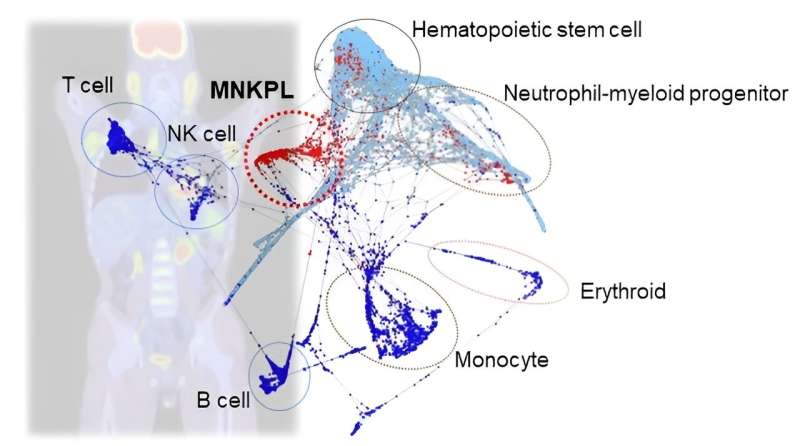This article has been reviewed according to Science X's editorial process and policies. Editors have highlighted the following attributes while ensuring the content's credibility:
fact-checked
peer-reviewed publication
trusted source
proofread
Research better characterizes a rare form of leukemia on the molecular level

Leukemia is a common term used to refer to a form of blood cancer. However, there are different types of leukemia depending on the cell type involved. One unique form is myeloid/natural killer (NK) cell precursor acute leukemia (MNKPL). Because of its rarity, no consensus exists on the specific clinical characteristics needed to identify this disease.
In a recent article published in Science Advances, a team led by researchers at Tokyo Medical and Dental University (TMDU) used various approaches to assess better the molecular profile and drug sensitivity characteristics of MNKPL.
MNKPL was only first proposed as a leukemia subtype in 1997. Extramedullary involvement is one of the hallmarks of MNKPL. It is prevalent in East Asian countries. Although the immunological phenotype of MNKPL was explored previously, a full genetic characterization of this cancer type had not been performed.
These details would help support more accurate diagnoses for patients, leading to more appropriate therapeutic decisions. Therefore, the TMDU group aimed to investigate MNKPL on a single-cell level.
"A single-cell exploration of MNKPL would not only help us better understand its clinical and genomic features but also clarify the specific cellular origin of this disease," says Dr. Akira Nishimura, lead author of the study.
The team first used what is known as a multiomics approach to investigate MNKPL patient samples. They used various sequencing technologies to determine if there were any relevant mutations in specific genes, look for expression differences in certain signaling pathways at the RNA level, and examine any unique DNA methylation patterns.
"Our results demonstrate that MNKPL has molecular qualities that are distinct from other similar cancers, such as acute myeloid leukemia, T-cell acute lymphoblastic leukemia, and mixed-phenotype acute leukemia," explains Dr. Masatoshi Takagi, senior author. "Specific hallmarks of MNKPL include activation of the NOTCH1 and RUNX3, as well as lower expression of the BCL11B."
Further work at the single-cell level in MNKPL cells showed that NK cells and myeloid cells come from a common progenitor cell type.
The researchers also conducted in vitro drug sensitivity assays to measure MNKPL cell responses to 79 individual anti-cancer drugs.
"We observed that MNKPL cells were highly sensitive to a drug called L-asparaginase, which has already shown clinical effectiveness for this disease," says Dr. Nishimura. "Mechanistically, we found that this was from the low expression of asparagine synthetase, a quality that was distinct from other similar types of leukemia."
Overall, the robust and comprehensive analysis performed in this study provides crucial molecular details for characterizing MNKPL. This work will undoubtedly help clinicians more effectively diagnose MNKPL and choose a therapeutic option. Additionally, this work provides data that will assist with novel therapeutic target identification and drug development in this leukemia.
More information: Akira Nishimura et al, Myeloid/natural killer (NK) cell precursor acute leukemia as a distinct leukemia type, Science Advances (2023). DOI: 10.1126/sciadv.adj4407



















